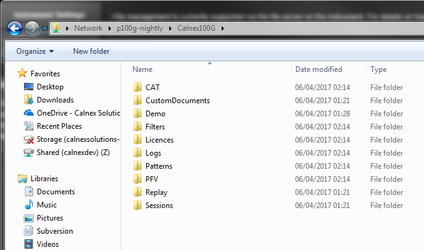
Paragon-100G: Getting Capture Files and Logs
When raising a Service Request with the Calnex Technical Support team, you will often be asked to provide capture data and log files. This article shows you how to find these files for Paragon-100G.
Paragon-100G Session Folders and CAT Logs
The capture files are stored on the internal filesystem in the instrument. To download them:
- Click File in the top right hand menu
- Click File Management in the left-hand menu
- You will then see instructions on how to connect to the instrument from Windows, Unix and MacOS.
- Assuming you are using Windows, copy the URL from the P100G UI and paste it into File Explorer. You should see something similar to that shown in the image below.
- The Sessions folder contains sub-folders each of which contains all the information for a given measurement / capture. Select the Session folder you want (check the date) and copy the entire folder onto your local PC

Note: you may be asked for a username and password. You can simply ignore this - either press OK or enter any string.
Log files are also stored on the internal filesystem. These are stored in the top level .\Logs folder
In both cases, the entire folder should be copied to your local PC.
Accessing the Paragon-100G Internal Filesystem
The filesystem is accessed using Samba. If you cannot access the filesystem using File Explorer, then this is likely to be due to the Samba ports being blocked by switches or routers in your network or by an IT security policy on your PC. To resolve this, you will need to contact your IT department. Before doing so, you may want to check the following:
- Your firewall and antivirus software:
- You should have ONLY ONE anti-virus/firewall package installed. Having multiple anti-virus/firewalls is not recommended practice
- If a firewall is installed on the local machine, it must allow outgoing traffic on ports 139 and 445. Check the logs/config to see whether these ports are being blocked.
Note: Your PC connects to the instrument using Samba; the ports above are those on which the instrument will listen - Your network adaptor:
- Go to the Network and Sharing Centre, then Change Adaptor Settings. Right-click the adaptor you are using and select Properties. Make sure that Client for Microsoft Networks is selected.
- The network set up:
- In a large organisation, the Paragon-100G instruments and the local PC may end up being on different subnets or connected through a number of switches and routers. In this case, it may not be the local PC that is blocking ports but one of the switches and/or routers in the path. To check this, you can use the portqry utility (from https://www.microsoft.com/en-us/download/details.aspx?id=17148). Install this and then run the following commands:
portqry -n <InstrIP> -p tcp -e 139portqry -n <InstrIP> -p tcp -e 145
If the result is LISTENING, then there probably isn't a port blocking problem. If the result is anything else (e.g.FILTERED), then the port is being blocked.
If the ports are being blocked in the network the problem cannot be resolved by Calnex. Either your IT organisation opens up these ports or the your PC has to be positioned in the network such that the ports are accessible (perhaps moving it into the same subnet as the instrument).
How do I get capture files if I can't see the instrument in File Explorer?
In some organisations, local IT policy blocks the ports required by Samba (SMB) so File Explorer can't be used to access the instrument's storage.
A workaround is available for this issue using a Tcl-based utility (CxDiag). This can connect to the instrument and allow the user to download a specific session folder (and also the instrument log files). The getting started guide for CxDiag can be found here.
Downloaded files will be saved in a folder named CxDiagData_<serialNumber> in the same location as the utility. Subfolders for Sessions and Logs will be created.
If you are requesting support, the entire CxDiagData folder should be zipped up and attached to your request.
We are also aware of issues with Windows 10 PCs that may block SMB access. Further information on how to resolve these may be found in this article.
Related articles
-
Page:
-
Page:
-
Page:
-
Page:
-
Page:
-
Page:
-
Page:
-
Page:
-
Page:
-
Page:
On this page:
